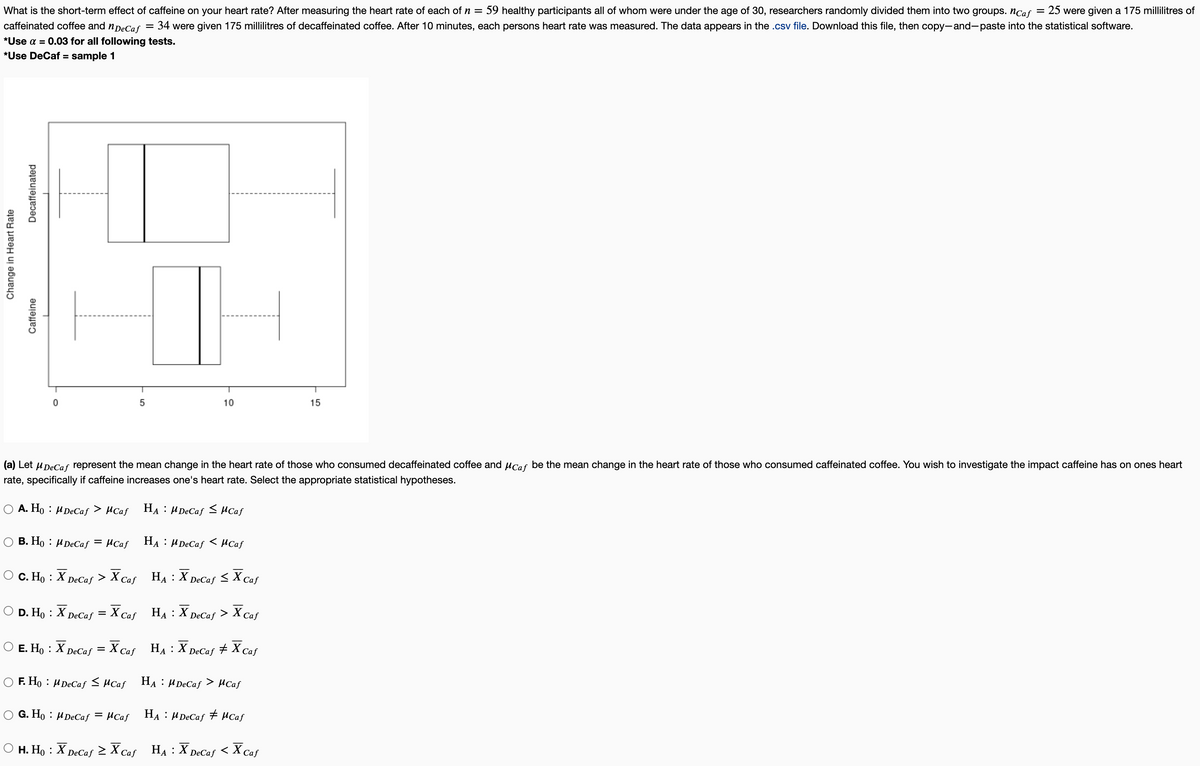(b) Levenes Test was applied to the data that is summarized in the boxplots. This produced a P-value of 0.193335426174131. Given what you know about these data, compute the test statistic used to test the null hypothesis in part (a) . Test Statistic = (Use three decimals in your answer) (c) Compute the P-value of the result in part (b). P-value = (Use four decimals your answer) (d) Correctly complete the concluding statement. Use a = 0.03. a) fail to reject a) median From these data, I would b) reject v the null hypothesis. From these data, I can infer that the mean v change in the heart rate between those who consumed Decaffeinated coffee and those who consumed Caffeinated coffee is statistically a significant bí insignificant c) standard deviation (e) Complete the 97% confidence interval estimate for the difference in the mean heart rate change between Decaffeinated and Caffeinated coffee drinkers. Ensure you use three decimals in each of your answers. < H DeCaf - HCaf <
Inverse Normal Distribution
The method used for finding the corresponding z-critical value in a normal distribution using the known probability is said to be an inverse normal distribution. The inverse normal distribution is a continuous probability distribution with a family of two parameters.
Mean, Median, Mode
It is a descriptive summary of a data set. It can be defined by using some of the measures. The central tendencies do not provide information regarding individual data from the dataset. However, they give a summary of the data set. The central tendency or measure of central tendency is a central or typical value for a probability distribution.
Z-Scores
A z-score is a unit of measurement used in statistics to describe the position of a raw score in terms of its distance from the mean, measured with reference to standard deviation from the mean. Z-scores are useful in statistics because they allow comparison between two scores that belong to different normal distributions.
Some data is intentionally missing. By hand or R-Studio is fine
Thanks in advance!
|
|
DeCaf |
Caf |
|
1 |
11.5 |
3.3 |
|
2 |
0.2 |
4.8 |
|
3 |
4 |
10.6 |
|
4 |
6.7 |
8.3 |
|
5 |
13.4 |
5.7 |
|
6 |
16.1 |
3.2 |
|
7 |
14.1 |
6.8 |
|
8 |
10.3 |
5.9 |
|
9 |
6.9 |
5.2 |
|
10 |
6.7 |
9.4 |
|
11 |
4.1 |
8.8 |
|
12 |
7.6 |
12.7 |
|
13 |
6.5 |
1.1 |
|
14 |
11.4 |
8.6 |
|
15 |
5.1 |
11.1 |
|
16 |
10 |
9.9 |
|
17 |
6.7 |
6.3 |
|
18 |
6.8 |
8.5 |
|
19 |
1.4 |
9.5 |
|
20 |
2.4 |
6.2 |
|
21 |
2.7 |
10.6 |
|
22 |
3.1 |
5.6 |
|
23 |
2.6 |
3 |
|
24 |
4.5 |
12.9 |
|
25 |
0.6 |
8.3 |
|
26 |
4.4 |
|
|
27 |
0.2 |
|
|
28 |
0.7 |
|
|
29 |
4.5 |
|
|
30 |
5.1 |
|
|
31 |
12.2 |
|
|
32 |
3.6 |
|
|
33 |
3 |
|
|
34 |
10.3 |
|
|
35 |
|
|
|
36 |
|
|
|
37 |
|
|
|
38 |
|
|
|
39 |
|
|
|
40 |
|
|
|
41 |
|
|
|
42 |
|
|
|
43 |
|
|
|
44 |
|
|
|
45 |
|
|
|
46 |
|
|
|
47 |
|
|
|
48 |
|
|
|
49 |
|
|
|
50 |
|
|
|
51 |
|
|
|
52 |
|
|
|
53 |
|
|
|
54 |
|
|
|
55 |
|
|
|
56 |
|
|
|
57 |
|
|
|
58 |
|
|
|
59 |
|
|


Step by step
Solved in 5 steps









